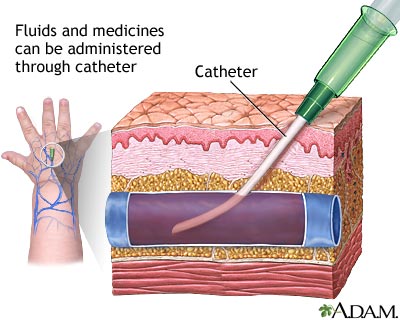Peripheral intravenous line - infants
PIV - infants; Peripheral IV - infants; Peripheral line - infants; Peripheral line - neonatal
A peripheral intravenous line (PIV) is a tiny, short, flexible tube, called a catheter. A health care provider puts the PIV through the skin into a vein in the scalp, hand, arm, or foot. The PIV can be attached to longer tubing to give medicine or fluids through the vein. This article addresses PIVs in babies.
Images

I Would Like to Learn About:
Information
WHY IS A PIV USED?
A provider uses the PIV to give fluids or medicines to a baby.
HOW IS A PIV PLACED?
Your provider will:
- Clean the skin.
- Stick the small catheter with a needle on the end through the skin into the vein.
- Once the PIV is in the proper position, the needle is taken out. The catheter stays in the vein.
- The PIV is connected to a small plastic tube that connects to an IV bag.
WHAT ARE THE RISKS OF A PIV?
PIVs can be hard to place in a baby, such as when a baby is very chubby, sick, and/or small. In some cases, the provider cannot put in a PIV. If this happens, another therapy is needed.
PIVs may stop working after only a short time. If this happens, the PIV will be taken out and a new one will be put in.
If a PIV slips out of the vein, fluid or medicine can go into the skin instead of the vein. When this happens, the IV is considered "infiltrated." The IV site will look puffy and may be red. Sometimes, an infiltrate may cause the skin and tissue to get very irritated. The baby can get a tissue burn if the medicine that was in the IV is irritating to the skin. In some special cases, a counteracting medicine may be injected into the skin to help prevent long-term skin damage from an infiltrate.
When a baby needs IV fluids or medicine over a long period of time, a midline catheter or PICC is used. Regular IVs only last 1 to 3 days before needing to be replaced. A midline or PICC can stay in for 2 to 3 weeks or longer.
References
Center of Disease Control and Prevention website. Intravascular catheter-related infection (BSI) prevention guidelines. www.cdc.gov/infection-control/hcp/intravascular-catheter-related-infection/?CDC_AAref_Val=https://www.cdc.gov/infectioncontrol/guidelines/BSI/index.html. Updated April 12, 2024. Accessed June 19, 2024.
Edwards LR, Malone MP, et al. Pediatric vascular access and centeses. In: Fuhrman BP, Zimmerman JJ, eds. Fuhrman and Zimmerman's Pediatric Critical Care. 6th ed. Philadelphia, PA: Elsevier; 2022:chap 14.
BACK TO TOPReview Date: 12/31/2023
Reviewed By: Mary J. Terrell, MD, IBCLC, Neonatologist, Cape Fear Valley Medical Center, Fayetteville, NC. Review provided by VeriMed Healthcare Network. Also reviewed by David C. Dugdale, MD, Medical Director, Brenda Conaway, Editorial Director, and the A.D.A.M. Editorial team.

Health Content Provider
06/01/2025
|
A.D.A.M., Inc. is accredited by URAC, for Health Content Provider (www.urac.org). URAC's accreditation program is an independent audit to verify that A.D.A.M. follows rigorous standards of quality and accountability. A.D.A.M. is among the first to achieve this important distinction for online health information and services. Learn more about A.D.A.M.'s editorial policy, editorial process and privacy policy. A.D.A.M. is also a founding member of Hi-Ethics. This site complied with the HONcode standard for trustworthy health information from 1995 to 2022, after which HON (Health On the Net, a not-for-profit organization that promoted transparent and reliable health information online) was discontinued. |
The information provided herein should not be used during any medical emergency or for the diagnosis or treatment of any medical condition. A licensed medical professional should be consulted for diagnosis and treatment of any and all medical conditions. Links to other sites are provided for information only -- they do not constitute endorsements of those other sites. © 1997- 2024 A.D.A.M., a business unit of Ebix, Inc. Any duplication or distribution of the information contained herein is strictly prohibited.
